
Hugs, kisses, welcome back.
It's been over 4 months since my last confession. Sorry, I've been working. A lot. Living in the land of the Rising Sun, yet I rarely see it. But it's definitely the type of challenge I came here for - one with no easy answers. The issues we're facing here on a daily basis range from "imminent calamity" to "unmitigated disaster"..and that's just ordering dinner. But you're not interested in that. So my goal here is to give you a glimpse into a very different world - a world outside the walls of my office - a little place I like to call 'the bazaar.'

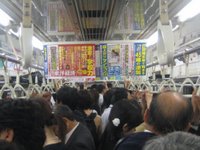 Tokyo has 13 million people, yet everyone seems to board the exact same train each morning. A simple rule of the subway system: "To get from Point A to Point B...you can't." Here's the map. It's a valuable study in the shortcomings of decision-by-committee. Statistics show the average Tokyo-ite will spend 6 years commuting to work, proving their threabare piety to the almight corporation. Hours are long, and the people are short. By the end of each week, 'salarymen' and 'office ladies' are absolutely beat. Binge drinking is encouraged as a public articulation of the effort you put forth in the past week. Here's a few people proving they just might be management material.
Tokyo has 13 million people, yet everyone seems to board the exact same train each morning. A simple rule of the subway system: "To get from Point A to Point B...you can't." Here's the map. It's a valuable study in the shortcomings of decision-by-committee. Statistics show the average Tokyo-ite will spend 6 years commuting to work, proving their threabare piety to the almight corporation. Hours are long, and the people are short. By the end of each week, 'salarymen' and 'office ladies' are absolutely beat. Binge drinking is encouraged as a public articulation of the effort you put forth in the past week. Here's a few people proving they just might be management material. ..
..

Japanese have a strange love/hate relationship with foreingers. Richard Gere's face is veritable wallpaper across Tokyo streets & trains, Tommy Lee Jones' brutish mug hawks iced coffee, and Tom Cruise is anything but risky business. But outside of celebrity marketing, 'xenophobia' is a term that gets tossed around in ex-pat circles.
 Frankly I see mixed evidence, and have discovered that the notorious distrust of outsiders tends to have more to do with individual insecurity rather than a broader social resistance - as many friendly Japanese acquaintances & colleagues would agree. However, you can find signs outside of some restaurants saying "No Foreigners" (incidentally these signs are written in Japanese...so I doubt their inherent effectiveness.) But a fairly accurate gauge on a country's openess is their refugee policy. In 2004, the U.S. accepted 21,148 refugees. In that same year, the UK accepted 12,925. How many did Japan accept?...15. I guess there's still some room for improvement. And let me take this opportunity to publicly thank Japan's immigration department for opening their doors to me. "Domo arigatoo Mr. Robato."
Frankly I see mixed evidence, and have discovered that the notorious distrust of outsiders tends to have more to do with individual insecurity rather than a broader social resistance - as many friendly Japanese acquaintances & colleagues would agree. However, you can find signs outside of some restaurants saying "No Foreigners" (incidentally these signs are written in Japanese...so I doubt their inherent effectiveness.) But a fairly accurate gauge on a country's openess is their refugee policy. In 2004, the U.S. accepted 21,148 refugees. In that same year, the UK accepted 12,925. How many did Japan accept?...15. I guess there's still some room for improvement. And let me take this opportunity to publicly thank Japan's immigration department for opening their doors to me. "Domo arigatoo Mr. Robato." Chaos Theory'
Def: The behavior of nonlinear dynamical systems that exhibit chaos and appear to be random, even though the system is deterministic in the sense that it is well defined and contains no random parameters. Examples of such systems include the atmosphere, the solar system, plate tectonics, turbulent fluids, economics...
...and outdoor advertising in Tokyo. But we advertisers have to fish where the fish swim, and I'm already guilty of adding to the clutter.

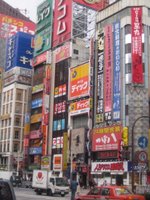 Not to talk shop, but there's no shortage of bad ads in Japan.
Not to talk shop, but there's no shortage of bad ads in Japan.  Regardless of language, most of it simply lacks an idea. However, in the case of Coca-Cola's agency, I do admire the sheer audacity of the team who pitched one particular slogan. The brief to the agency likely asked for a reason consumers should choose Coca-Cola...to which the agency came back with "No Reason." There's nothing Lost in Translation here, the line is just bad. But Coca-Cola bought it. So for the agency, the post-presentation exuberation must have felt tremendous. Unfortunately for them, it was also short-lived. I have recently befriended the NEW strategic planner for Coca-Cola Japan, as she's just finished tearing the account away from the old agency...for no reason.
Regardless of language, most of it simply lacks an idea. However, in the case of Coca-Cola's agency, I do admire the sheer audacity of the team who pitched one particular slogan. The brief to the agency likely asked for a reason consumers should choose Coca-Cola...to which the agency came back with "No Reason." There's nothing Lost in Translation here, the line is just bad. But Coca-Cola bought it. So for the agency, the post-presentation exuberation must have felt tremendous. Unfortunately for them, it was also short-lived. I have recently befriended the NEW strategic planner for Coca-Cola Japan, as she's just finished tearing the account away from the old agency...for no reason.


 Doing a lot of business in Korea these days, and Seoul is a brilliant city. It exudes more than the small-town charm typical of most Asian cities over 10 million people. The people here are genuinely friendly, intelligent, and hard-working. If you like spicy, the food is absolutely on fire. Here's a shot of my colleague and I after taking in a little traditional dinner & dancing. (Not sure why I look so wooden.) Anyways, what makes Korea truly great is not the people, food, or culture...it's the way they park cars.
Doing a lot of business in Korea these days, and Seoul is a brilliant city. It exudes more than the small-town charm typical of most Asian cities over 10 million people. The people here are genuinely friendly, intelligent, and hard-working. If you like spicy, the food is absolutely on fire. Here's a shot of my colleague and I after taking in a little traditional dinner & dancing. (Not sure why I look so wooden.) Anyways, what makes Korea truly great is not the people, food, or culture...it's the way they park cars. 

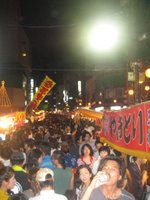 But some are a bit silly; no playing sports in parks, and say hello using "sumimasen" (which translates directly to "I'm sorry"). But no matter how well one assimilates themselves with the local peculiarities, nobody should ever get used to the idea of a $200 piece of fruit. Check out the melons in this photo, and do the math yourself. And also look at the bench in this photo - marked with no less than 9 warning signs. An indication of how repression manifests itself in strange ways.
But some are a bit silly; no playing sports in parks, and say hello using "sumimasen" (which translates directly to "I'm sorry"). But no matter how well one assimilates themselves with the local peculiarities, nobody should ever get used to the idea of a $200 piece of fruit. Check out the melons in this photo, and do the math yourself. And also look at the bench in this photo - marked with no less than 9 warning signs. An indication of how repression manifests itself in strange ways. 

Life is like a box of chocolates. So is buying a soft drink in Japan. Drinks can have sequels such as "Bubble Man 2", or even an extraordinary "50 lemons worth of Vitamin C in every can!" Anything in a dark bottle is pretty much a gamble, but you learn to look fear straight in the eye and say "hmmm...that one".


Redundancy:
Function: noun
a) the quality or state of being redundant
b) an act or instance of needless repetition
c) the part of a message that can be eliminated without loss of essential information
 A lot of people have jobs in Japan. Maybe too many. I'm not saying the idea of 'lifelong employment' isn't the shangri-la we should all steer towards, but every system has its inherent flaws. Yes, this is a photo of a robotic traffic dummy - and he's doing a great job. But if I pulled back on the focus, you'd see about 8 real humans doing the same thing within about 2 feet of each other. Now the fact is this construction site is already lit up like a Christmas tree...so nobody's adding value and they know it. But you can't fire these people. In fact, you need to give them salary raises as time goes on. Now in this case, I don't believe they're hiring any new young talent (darn...missed my chance.) So it creates a contextual scene where workers are quite literally standing next to the machine that will one day replace them. Personally, I'd rather be layed off than work unproductively next to 'Johnny Right-Arm'. But for those who don't have that guilt switch flicked on in their head, I suppose it's a nice way to put a horse out to pasture.
A lot of people have jobs in Japan. Maybe too many. I'm not saying the idea of 'lifelong employment' isn't the shangri-la we should all steer towards, but every system has its inherent flaws. Yes, this is a photo of a robotic traffic dummy - and he's doing a great job. But if I pulled back on the focus, you'd see about 8 real humans doing the same thing within about 2 feet of each other. Now the fact is this construction site is already lit up like a Christmas tree...so nobody's adding value and they know it. But you can't fire these people. In fact, you need to give them salary raises as time goes on. Now in this case, I don't believe they're hiring any new young talent (darn...missed my chance.) So it creates a contextual scene where workers are quite literally standing next to the machine that will one day replace them. Personally, I'd rather be layed off than work unproductively next to 'Johnny Right-Arm'. But for those who don't have that guilt switch flicked on in their head, I suppose it's a nice way to put a horse out to pasture. By the way...did I mention Richard Gere is big here?
By the way...did I mention Richard Gere is big here?
 Japan is much more than Tokyo. My lovely & talented friend Megan recently visited recently on her way to humanitarian work in Vietnam, which was the perfect catalyst to get out of the office and see a little more of the bazaar. Sumo wrestling was up first. The September Grand Tournament in Kokugikan is steeped in ritual. Pre-fight cermemonies resemble a catwalk fashion show, wrestlers through salt into the 'dohyo' ring for purification, and water is sipped from wooden buckets (no Gatorade here). Refreshingly, it's also one of the few activities in Japan where hierarchy seems to based on merit. So if you can make it through several hours of huge naked ass, you get to see the hugest naked ass of them all - ironically named "Asashoryu". He never looses a match. Except when we went. Here's what happened when he lost! Don't worry about the hailstorm of cushions...I eventulally regained consciousness.
Japan is much more than Tokyo. My lovely & talented friend Megan recently visited recently on her way to humanitarian work in Vietnam, which was the perfect catalyst to get out of the office and see a little more of the bazaar. Sumo wrestling was up first. The September Grand Tournament in Kokugikan is steeped in ritual. Pre-fight cermemonies resemble a catwalk fashion show, wrestlers through salt into the 'dohyo' ring for purification, and water is sipped from wooden buckets (no Gatorade here). Refreshingly, it's also one of the few activities in Japan where hierarchy seems to based on merit. So if you can make it through several hours of huge naked ass, you get to see the hugest naked ass of them all - ironically named "Asashoryu". He never looses a match. Except when we went. Here's what happened when he lost! Don't worry about the hailstorm of cushions...I eventulally regained consciousness.

 So from one naked ass to the next, it was off to sit in a sulphur hot spring with old wrinkly Japanese men. No, that's not me. The conversation with strangers is naturally skin deep, but I highly recommend you try the experience.
So from one naked ass to the next, it was off to sit in a sulphur hot spring with old wrinkly Japanese men. No, that's not me. The conversation with strangers is naturally skin deep, but I highly recommend you try the experience.




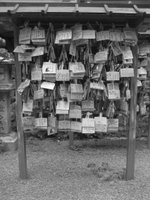

 Then Kyoto - a word that in Japan means more than just broken global promises on pollution controls. Famed for its ancient temples and traditoinal culture, spotting a real 'Geisha' is as rare as spotting deer in downtown. Well, actually that's a terrible analogy...especially after having visited Nara (Japan's original capital) where deer literally run rabid through every street. But let me first finish with Kyoto. There are reputedly less than 100 geishas left in all of Japan...and thus the world. Luckily I was able to see one! Her beautiful kimono, wooden shoes, rotten teeth...the whole bit.
Then Kyoto - a word that in Japan means more than just broken global promises on pollution controls. Famed for its ancient temples and traditoinal culture, spotting a real 'Geisha' is as rare as spotting deer in downtown. Well, actually that's a terrible analogy...especially after having visited Nara (Japan's original capital) where deer literally run rabid through every street. But let me first finish with Kyoto. There are reputedly less than 100 geishas left in all of Japan...and thus the world. Luckily I was able to see one! Her beautiful kimono, wooden shoes, rotten teeth...the whole bit.  If you visit Kyoto, it's temple madness. Gold ones. Silver ones. Big ones. Small ones. But like all things Japan, the antiquated co-exist with the ultra-modern. So after sipping the tea and bowing the buddhas, you can drop by this Bathing Ape store and pick up a U.S.$1,000 t-shirt. Yup. $1,000.
If you visit Kyoto, it's temple madness. Gold ones. Silver ones. Big ones. Small ones. But like all things Japan, the antiquated co-exist with the ultra-modern. So after sipping the tea and bowing the buddhas, you can drop by this Bathing Ape store and pick up a U.S.$1,000 t-shirt. Yup. $1,000. 
So then off to Nara. Yada Yada Yada...here's the deer: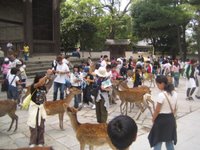


A must-do on anyone's itinerary here is a Japanese baseball game. It's certainly no afternoon at Candlestick Park. The fans are insane. Each player gets their own song, which is belted with fervor at each batting attempt. North American has the "7th-inning stretch". In Osaka, they've got this.


So that's it for now. It's Saturday night, and unfortunately there's work to be done. If you happen to find yourself on an airplane bound for Tokyo, feel free to stop and visit an old friend. It'll be a good excuse to get out and see more of the bazaar. There's plenty of room in my loft for guests, and two computer-powered toilets to blow you away. Plus I'm just a few blocks away from the world's largest fish market (sushi fans be warned), and right next door to my good friend & colleague Darren. Anyways, the place is great. Here's Darren trying to burn it all down.

By the way, has everyone been to visit Columbia by now??...hope so.
Until next time.
Neill







